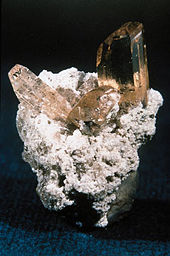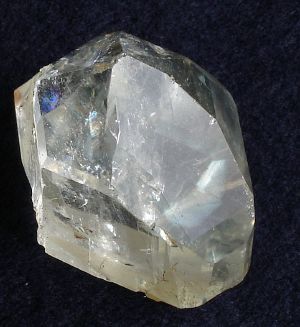Topaz
- This article is about the mineral or gemstone. For other uses of the term, see Topaz (disambiguation).
| Topaz | |
|---|---|
 an unfinished topaz crystal |
|
| General | |
| Category | Mineral |
| Chemical formula | Al2SiO4(F,OH)2 |
| Identification | |
| {{{molweight}}} | |
| Color | Clear (if no impurities); also see Varieties |
| Crystal system | orthorhombic |
| Fracture | conchoidal |
| Mohs Scale hardness | 8 |
| Luster | Vitreous/glossy |
| Specific gravity | 3.4-3.6 |
| {{{density}}} | |
Topaz is a silicate mineral of aluminium and fluorine with the chemical formula Al2SiO4(F,OH)2. It crystallizes in the orthorhombic system and its crystals are mostly prismatic terminated by pyramidal and other faces, the basal pinacoid often being present. It has an easy and perfect basal cleavage, meaning that gemstones or other fine specimens have to be handled with care to avoid developing cleavage flaws. The fracture is conchoidal to uneven. Topaz has a hardness of 8, a specific gravity of 3.4-3.6, and a vitreous luster. Pure topaz is transparent but is usually tinted by impurities; typical topaz is wine or straw-yellow. They may also be white, gray, green, blue, pink or reddish-yellow and transparent or translucent. When heated, yellow topaz often becomes reddish-pink. It can also be irradiated, turning the stone a light and distinctive shade of blue. A recent trend in jewelry is the manufacture of topaz specimens that display iridescent colors, by applying a thin layer of titanium oxide via physical vapor deposition. The most famous gemstone created by physical vapor deposition to date is "Mystic Fire Topaz". Azotic Coatings patented the name "Mystic Fire Topaz" in 1998.
Topaz is commonly associated with silicic igneous rocks of the granite and rhyolite type. It typically crystallizes in granitic pegmatites or in vapor cavities in rhyolite lava flows like those at Topaz Mountain in western Utah. It may be found with fluorite and cassiterite. It can be found in the Ural and Ilmen mountains, Afghanistan, Czech Republic, Germany, Norway, Pakistan, Italy, Sweden, Japan, Brazil, Mexico, and the United States.
The biggest topaz crystal ever found - named "El Dorado" - was found in Brazil in 1984. It weighs 6.2 kg and belongs to the British Royal Collection.
Etymology and historical and mythical usage
The name "topaz" is derived from the Greek topazos, "to seek ," which was the name of an island in the Red Sea that was difficult to find and from which a yellow stone (now believed to be a yellowish olivine) was mined in ancient times. In the Middle Ages the name topaz was used to refer to any yellow gemstone, but now the name is only properly applied to the silicate described above.
According to Rebbenu Bachya, the word "Leshem" in the verse Exodus 28:19 means "Topaz" and was the stone on the Ephod representing the tribe of Dan.
Yellow topaz is the traditional November birthstone.
ReferencesISBN links support NWE through referral fees
- Hurlbut, Cornelius S.; Klein, Cornelis, 1985, Manual of Mineralogy, 20th ed., ISBN 0-471-80580-7
External links
ar:زبرجد bg:Топаз cs:Topaz de:Topas et:Topaas es:Topacio fr:Topaze (minéral) ko:홍옥 hr:Topaz he:טופז lt:Topazas hu:Topáz nl:Topaas ja:トパーズ no:Topas ug:سېرىق قاشتېشى pl:Topaz pt:Topázio ro:Topaz ru:Топаз fi:Topaasi sv:Topas tr:Topaz zh:黄玉

